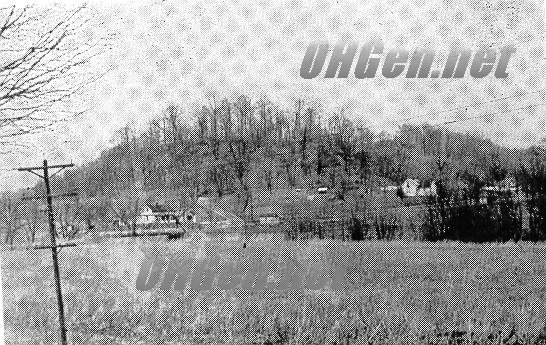
Another take on the Millfield Mine Disaster
donated by Susan Leffler
Susan_Leffler@email.msn.com
"The Harris History, A Collection of Tales of Long Ago of Southeastern Ohio and Adjoining Territories," by Charles H. Harris, published by The Athens Messenger, 1957. Provided with permission from The Athens Messenger.
WORST DISASTER IN OHIO MINING HISTORY HAPPENED UNDER HIGH HILL NEAR MILLFIELD

{ Pictured above is the hill beneath which most of the victims of the Millfield mine disaster, Ohio' s worst underground tragedy, lost their lives shortly after noon of Wednesday, November 5, 1930. This hill is just north of Millfield on Route 13 and the picture was taken from near the Sanders home at the upper edge of town.
A country road leads from Route 13 immediately north of this point across an iron bridge, and up the h ill and to the left of this country road was the airshaft from which some of the men working in the mine escaped. The airshaft is now filled. Only those men near its bottom made their way to safety while four score and more others, including officials o f the Sunday Creek Coal Co., and some of their customers perished while making an inspection trip through the works.
The airshaft which saved the lives of some men, was one of the recent improvements of the huge mine, known as No. 6, and it was near its bo ttom and under the hill shown here most of the fatalities occurred. The operation was the largest and best equipped in the Hocking coal fields.
Eighty-two men lost their lives in this explosion of methane gas which had accumulated and the disaster was ca used by a short circuit between the trolley wire and rail, according to a finding by the Athens County coroner, L.F. Jones. The testimony of many witnesses totaled three million words and it was stated that " the origin of the gas at this point, at this time is undetermined by testimony of any witness."
Fifty-nine women were made widows in this disaster and seventy-nine sons and seventy-five daughters of various ages, were made fatherless. The health of the few who survived was wrecked in a number of case s. Many families were several times sorrowed\emdash one mother lost five sons. No other mine disaster in Ohio ever approached the number of fatalities recorded at No. 6 mine. In 1910, fifteen miners died in a gas explosion at Amsterdam Mine in Jefferson County . In 1906, five men fell to their deaths in San Toy Mine No. 1 in Perry County; while at Jobs several years before the Millfield disaster, four or five men died at Jobs in a Hocking County mine tragedy.
The new airshaft was 170 feet deep. When the explo sion took place, W.E. Titus, president of the coal company, other officials and customers of the coal company, with miners as guides, were on a tour of inspection. The party had entered the main shaft near East Millfield and had gone nearly a mile and ha l f when the disaster, which killed every member of the special party, took place. Miners all over the workings were killed, save for a few who made their way to the surface through the airshaft and 21 men who bratticed themselves off from the gas in a dis tant part of the mine. They were rescued 12 hours after the explosion after seeing men die all about them.
Soon all roads leading to the mine were crowded with rescue crews of the federal and state governments and ambulances. The work of rescue began at once and by midnight the removal of bodies began. The burial of victims was made by the state, allowing $150 in each case. Dependents were compensated at the rate of $18.75 a week until exhaustion of a death claim of $6500 under the workmen\rquote s compensatio n law. By March 1940, the state had paid to No. 6 miners and dependents a total of $712,391 as a result of this disaster, the worst in the history of the old Hocking coal field. Money was also expended from a state emergency fund for relief of survivors in need.
Many of the entries of No. 6 mine, hundreds of feet in length, were unusually wide with room for double tracks and switches, while their roofs were supported by steel beams 22 feet long. Often this mine was operated in several shifts. One Christmas pay totaled $58,000, the largest pay for two weeks in the history of the Hocking field. During that pay period, from this mine between 5,000 and 5,600 tons of coal were loaded every 24 hours.
No. 6 mine has not been in operation for a number of years. The main tipple stands along the country road leading east from Millfield (Route 13). Equipment of the mine was removed some time ago.